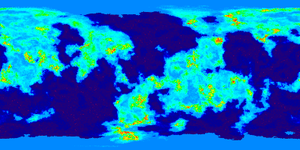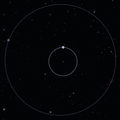Difference between revisions of "Kerbin/fr"
(→Reference Frames) |
|||
| Line 38: | Line 38: | ||
== Atmosphère == | == Atmosphère == | ||
| − | Kerbin | + | Kerbin a une atmosphère de composition inconnue, mais comme Kerbin possède des plantes et des animaux, on peut supposer qu'il y a O<sub>2</sub>, N<sub>2</sub>, et CO<sub>2</sub>. L'atmosphère se termine à environ 69.078 mètres et, comme sur Terre, devient exponentiellement moins dense quand l'altitude augmente (avec une échelle de hauteur de 5 km)<ref>{{forum link|threadID=16000|threadName=[KGSS] Examining Kerbin's atmosphere}}</ref> en général, la pression et la densité atmosphérique sur Kerbin, à une altitude exprimée en mètres, sont les suivantes: |
: <math>p_k = e^{-altitude/5000}</math> | : <math>p_k = e^{-altitude/5000}</math> | ||
: <math>d_k = 1.2223\ p_k</math> | : <math>d_k = 1.2223\ p_k</math> | ||
| − | <math>d_k</math> | + | <math>d_k</math> en kg/m^3 |
== Orbites == | == Orbites == | ||
Revision as of 17:51, 24 November 2012
Kerbin est la planète mère des Kerbals, on y trouve le Centre Spatial et toute les installation du Kerbal Space Program. Elle possède deux lunes nommées Mun et Minmus. C'est la 3e planète en orbite autour de Kerbol, une étoile de classe M. Elle est la troisième plus grosse planète en taille après Jool et Eve et le 4e objet céleste le plus imposant orbitant autour de Kerbol (la lune Tylo étant légèrement plus grande).
Contents
Topographie
Kerbin a environ la même proportion d'eau que de terre, avec des pôles glacial et des déserts dispersé. Les montagnes ne dépassent généralement pas 3km d'altitude. Le point le plus élevé est 3750 m .[1]
Atmosphère
Kerbin a une atmosphère de composition inconnue, mais comme Kerbin possède des plantes et des animaux, on peut supposer qu'il y a O2, N2, et CO2. L'atmosphère se termine à environ 69.078 mètres et, comme sur Terre, devient exponentiellement moins dense quand l'altitude augmente (avec une échelle de hauteur de 5 km)[2] en général, la pression et la densité atmosphérique sur Kerbin, à une altitude exprimée en mètres, sont les suivantes:
en kg/m^3
Orbites
Geosynchronous orbit is achieved at an altitude of 0,00 m (1008.9 m/s). A semi-synchronous orbit with an orbital period of 1/2 of Kerbal (3 hours or 10800 seconds) is achieved at an altitude of 0,00 m with an orbital velocity of 0,00 m/s.
Voyages Interplanétaires
From the lowest stable orbit around Kerbin (70 km), the amount of delta-V needed to reach the orbits of other celestials is as follows:
| Body | Delta-V | |
|---|---|---|
| Mun | ~860 m/s | |
| Minmus | ~930 m/s | |
| Eve | ~1033 m/s | |
| Duna | ~1060 m/s | |
| Moho | ~1676 m/s | |
| Jool | ~1915 m/s | |
Cadre de référence
| Officiel (0.17) | Démo (0.13.3) | |
|---|---|---|
| Transition rotative/inertielle | 100,000 m | 70,000 m |
| Warp | Altitude minimum | |
| 1x | Partout | |
| 2x | Partout | 0 m |
| 5x | A partir de 69,078 m (sortie de l’atmosphère) | |
| 10x | A partir de 69,078 m (sortie de l’atmosphère) | |
| 50x | 69,078 m | 150,000 m |
| 100x | 120,000 m | 300,000 m |
| 1,000x | 240,000 m | 600,000 m |
| 10,000x | 480,000 m | 1,200,000 m |
| 100,000x | 600,000 m | 1,200,000 |
Galerie
- NJ6qJ.jpg
La map aplatie de kerbin pendant la 0.14.2 et avant.
An accurate full-colour projection map of Kerbin as of 0.14.2 and above.
Mises à jour
- Improved atmosphere visuals.
- Minmus added.
- Much more varied and taller terrain added. Prior to this, some mountain ranges exceeded 600 m in height, but the tallest point was at an altitude of approximately 900 m.[3]
- Mun added.
- Terrain overhaul, oceans became wet.
- Atmosphere extended from ~34,500 m to ~69,000 m.
- Initial Release
Notes
- ↑ http://kerbalspaceprogram.com/forum/index.php?topic=11388.msg176509#msg176509 [Broken Link]
- ↑ Forum thread 16000, "[KGSS] Examining Kerbin's atmosphere"
- ↑ http://kerbalspaceprogram.com/forum/index.php?topic=6446.0 [Broken Link]







